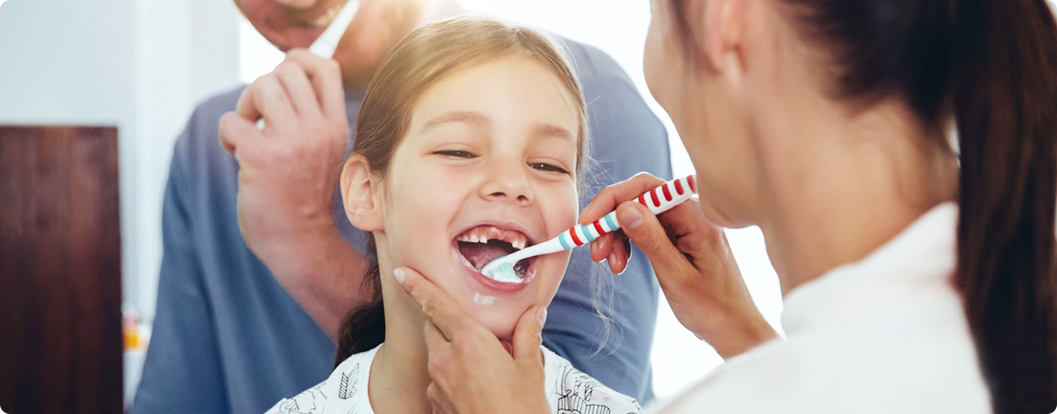Pediatric Oral Health: Baby Teeth Matter!
Who can resist that first toothless smile from an infant? But lurking just below the surface of all that drooling gummy cuteness are 2 rows of teeth just waiting to erupt. Babies are actually born with all 20 primary teeth in their jaws. These baby teeth are crucial to a young child’s development in chewing and speaking, and they also hold space in the jaw for permanent teeth.
It’s important to properly care for baby teeth, despite the fact that they will fall out. When a small child loses a baby tooth due to decay or an accident, it can affect the alignment of the permanent teeth below the surface, causing spacing problems as your child ages. Pediatric oral health including regular brushing, flossing, and dental visits will keep your kiddo’s teeth healthy until they are ready to come out naturally. Teach your children to brush and floss properly by helping them with the job until they have the motor skills to do it independently. Also remember that nutrition plays a big role in oral health, so keep sugary snacks and drinks to a minimum. Avoid letting babies go to sleep with a bottle, and older kids should never have anything but water after bedtime brushing.
When Do You Lose Your First Tooth?
According to the Mayo Clinic, children typically lose their first tooth around age 6, but it’s normal for it to happen as late as 7. Tooth eruption can be affected by several factors such as genetics (did you lose your teeth early or late?), nutrition, illness, or even body size. Kids who were premature babies, for example, may develop permanent teeth later because of their shorter gestation period. If the question of when you lose your first tooth is causing concern because your child seems to be behind his or her peers, see your pediatrician or dentist to rule out any major problems.
Baby teeth are pushed up and out by the permanent teeth moving into place, so the time between a tooth falling out and a new tooth appearing should not be too long. When baby teeth are allowed to shed naturally, kids do not usually experience much pain or discomfort. While wiggling a loose tooth may help the root naturally give way, pulling or yanking it out can result in pain and bleeding. Have your child gargle with warm water after losing a tooth, and make sure he or she is practicing good oral hygiene. Pediatric oral health is an ongoing and often exhausting task for parents, but your vigilance will help your children maintain a lifetime of healthy teeth.
Which tooth falls out first?
Baby teeth tend to fall out in the order they first erupted. You can typically expect the front teeth, or central incisors, to come out first, and the rest will follow mostly in line towards the back of the mouth. The second molars are usually out by age 12 or 13. Even though the teeth are being pushed out by permanent teeth, those bigger guys can take several months to grow fully into place. If a permanent tooth hasn’t come in 6 months after the loss of a baby tooth, consult with your child’s dentist.
Remember that there are 32 permanent teeth, including wisdom teeth, and only 20 baby teeth. So don’t be surprised when some of those molars start appearing all by themselves. Schedule regular dental visits and X-rays so your child’s dentist can help him or her maintain great oral health and head off any problems early.
Keep track of which teeth have fallen out with a special keepsake box from our shop. By marking your child’s age at each tooth loss, he or she will have a diary of sorts for the future. FlutterPop is working hard to help you make this diary digital so it can never be lost! Once your child becomes a parent as well, he or she can compare which tooth falls out first with your grandkids. By starting great pediatric oral health habits in your kids now, you can help to create a legacy of strong and healthy teeth for generations to come!
FlutterPop is invested in creating healthy teeth habits as early as possible. If you are as excited as we are about maintaining pediatric oral health in the digital age, sign up for our email list and follow us on Facebook and Instagram for progress on the FlutterPop website.

